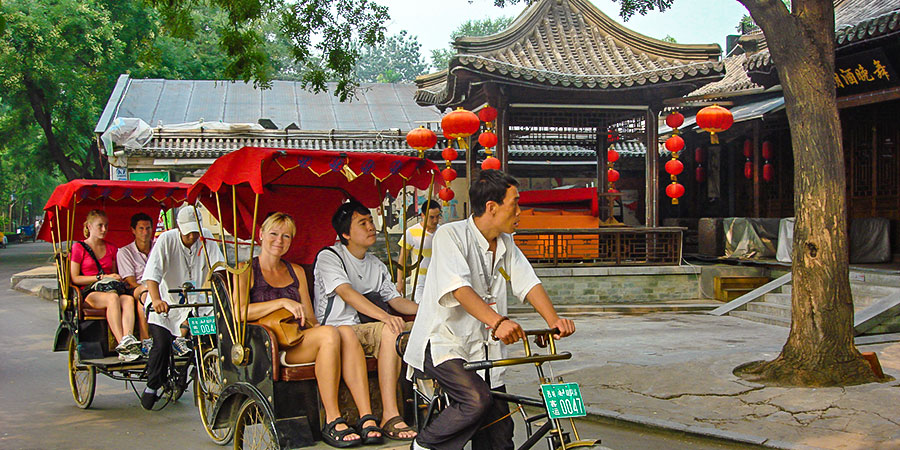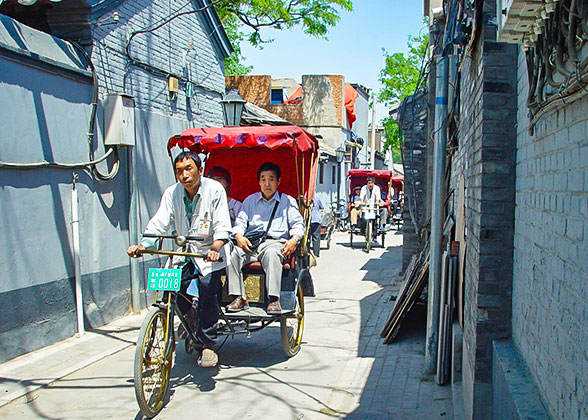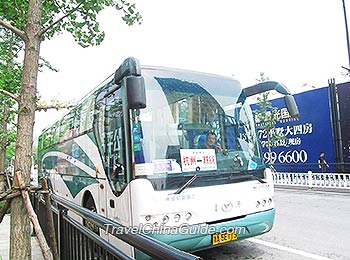 People say that the real culture of Beijing is "the culture of hutong" and "the culture of courtyard". How true that is. Often, it is Beijing's winding hutongs that attract tourists from home and abroad rather than the high-rise buildings and large mansions.
People say that the real culture of Beijing is "the culture of hutong" and "the culture of courtyard". How true that is. Often, it is Beijing's winding hutongs that attract tourists from home and abroad rather than the high-rise buildings and large mansions.
Hutong is a typical lane or small street in Beijing that originated during the Yuan Dynasty (1271-1368). "Hutong" is a Mongolian word, meaning "water well". During that time, water well is the settlement around which people lived. There are tens of thousands of hutongs surrounding the Forbidden City. In the past, Beijing was composed of countless courtyards. Hutongs were formed when people left a passageway between two courtyards to make entering them more convenient.
As the symbol of Beijing City, a hutong has its own layout and structure, which makes it a wonder in the world. When taking a bird's eye view of Beijing, you will find the combination of hutongs and courtyards just like an orderly chessboard with delicate gardens, fine rockeries, and ancient ruins. Hutongs have witnessed the development of Beijing. Where there is a hutong, there is a story.
Among the numerous hutongs in Beijing, Beixinqiao Hutong has the most turns. There are more than 20 in which you can easily get lost. The narrowest is Qian Shi Hutong (Money Market Hutong), measuring about 30 to 40 meters (32 to 44 yards), located in Zhubao Shi Street outside the Front Gate. The narrowest part is merely 40 centimeters (16 inches) wide, so when two people meet, they must turn sideways to pass each other. The longest one is Dong Jiaomin Hutong, with a total length of 6.5 kilometers (4 miles), lying between Chang'an Avenue and East Street and West Street of the Front Gate. The shortest one is Guantong Hutong measuring about 30 meters (33 yards).
Come and see it by hiring the rickshaw, and you'll have a true taste of Beijing!


The Culture of Hutong
The names of these Hutongs are all-embracing and various and relate to their location, origin or history, such as Lumicang Hutong, Fuxue Hutong, and Gongyuan Hutong, which were named by official organizations. Examples of Hutongs named by craftsmen and ordinary people include: ‘earthenware pot Liu Hutong' (now Dashaguo Hutong, maybe there once lived a Mr. Liu who sold earthenware pots) Wangzhima Hutong, and Mengduan Hutong. Hutongs named by their market trade include Xianyu Kou Hutong (Fish street), for it once was the place where fish was sold. There are also Hutongs which bear the names of horses and mules because these animals were once traded there. Some Hutongs take their name from special landmarks, such as Stone Tiger Hutong, Iron Lion Hutong and Cypress Hutong. Hutongs' names are regarded as important materials when researching Beijing culture.
People are pleased with their easy life in Siheyuan (the courtyard distributed orderly in Hutongs). They live a peaceful and harmonious life in these small "boxes", away from the hustle and bustle of the streets outside. Their daily needs could be fully satisfied by hawkers who sold vegetables, eggs, fruits, and snacks. In the past, they could even get their hair cut by the itinerant barbers without walking out of their neighbourhood to find a barber shop. The winding and narrow Hutongs were heaven for children playing games. They would have played rubber-band skipping, kicking shuttlecocks, and hide-and-seek. Even in modern times, young boys get together and hold football matches in these narrow lanes. Those who live in the Hutongs love their way of life so much that it is often described by the Chinese as a culture of happiness and harmony.
However, the love of this way of life can become a burden for some Hutong-dwellers. Because many people have never known anything outside of Hutong living, they can be reluctant to move house. People have been known to live in the same Hutong for decades, until the foundations are too weak to hold the weight of the house and until the roof allows rain in. But for these people, their house still had value because they loved the way of life that had lived there. In this insular environment, people live simply and happily but are unwilling to change.
The History of Hutong
Hutong is a narrow lane among courtyards. The history of hutongs can be traced back to Yuan Dynasty (1271 - 1368) when Beijing was the capital. After the establishment of Yuan authority, the nobles and heroes were pleased to be awarded with certain pieces of land as feudal estates. They actively built houses and courtyards which were arranged in order around water wells. The passages between houses were left in consideration of light and ventilation and convenient right-of way. Though these countless passages crisscrossed the old capital like a chessboard, there were only 29 of them called hutong. Because city planning was very strict at that time, the roads which measured 36 meters (39.4 yards) wide were called main streets. The 18-meter (19.7-yard)-wide roads were named side streets and those nine meters (9.8 yards) wide or less were designated as hutongs
Hutongs were also places where grain was stored to satisfy the needs of the royal court and armies and to feed the starving people in lean years. For example, Lumicang Hutong became famous because it was the location of Lumi Grain Depot. Lumi Grain Depot was built in the Ming Dynasty (1368 - 1644) and measured over 200 meters (218.7 yards) long, covering half length of the Lumicang Hutong.
In the Ming (1368 - 1644) and Qing Dynasty (1644 - 1911), city planning was less strict. Stallholders squeezed in the residential districts, which made the hutongs differ in width from over six meters (6.6 yards) to less than one meter (1.1 yards). What's more, hutongs at this time presented various appearances. Some hutongs, such as Koudai Hutong (Pocket Hutong) only had one entrance. Some hutongs, such as Jiudaowan Hutong (Nine Turning Hutong) had many twists and turns. Some hutongs even wound around a somewhat squared off circle like the Four Rings Hutong. Small retailers peddled their wares among the hutongs to satisfy people's daily needs. The basic appearance of hutongs was generally formed during these periods.





0 评论:
发表评论